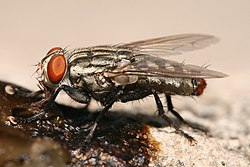| Calyptratae Temporal range: | |
|---|---|
 | |
| Scientific classification | |
| Kingdom: | Animalia |
| Phylum: | Arthropoda |
| Class: | Insecta |
| Order: | Diptera |
| Clade: | Eremoneura |
| (unranked): | Cyclorrhapha |
| Section: | Schizophora |
| Subsection: | Calyptratae |
| Superfamilies | |
Calyptratae is a subsection of Schizophora in the insect order Diptera, commonly referred to as the calyptrate muscoids (or simply calyptrates). It consists of those flies which possess a calypter that covers the halteres, among which are some of the most familiar of all flies, such as the house fly.
About 18,000 described species are in this group, or about 12% of all the flies yet described. [1]